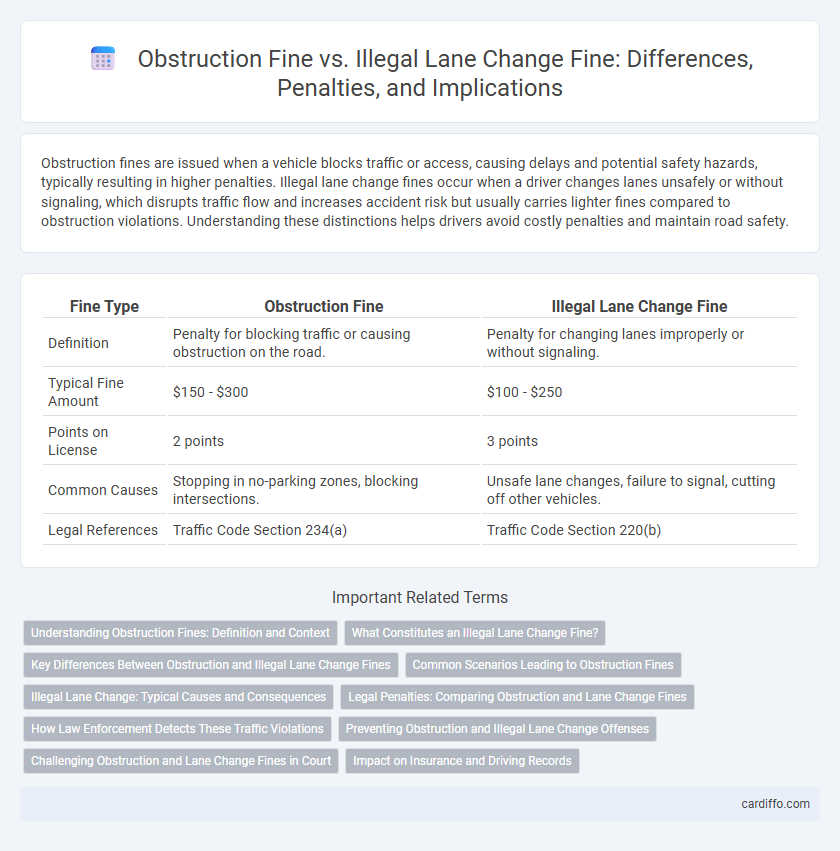Obstruction fines are issued when a vehicle blocks traffic or access, causing delays and potential safety hazards, typically resulting in higher penalties. Illegal lane change fines occur when a driver changes lanes unsafely or without signaling, which disrupts traffic flow and increases accident risk but usually carries lighter fines compared to obstruction violations. Understanding these distinctions helps drivers avoid costly penalties and maintain road safety.
Table of Comparison
| Fine Type | Obstruction Fine | Illegal Lane Change Fine |
|---|---|---|
| Definition | Penalty for blocking traffic or causing obstruction on the road. | Penalty for changing lanes improperly or without signaling. |
| Typical Fine Amount | $150 - $300 | $100 - $250 |
| Points on License | 2 points | 3 points |
| Common Causes | Stopping in no-parking zones, blocking intersections. | Unsafe lane changes, failure to signal, cutting off other vehicles. |
| Legal References | Traffic Code Section 234(a) | Traffic Code Section 220(b) |
Understanding Obstruction Fines: Definition and Context
Obstruction fines are penalties imposed for actions that block or hinder the normal flow of traffic, such as stopping a vehicle in a way that impedes other road users. These fines differ from illegal lane change fines, which specifically address unsafe or unauthorized movements between lanes designed to maintain traffic order and safety. Understanding obstruction fines involves recognizing how they target behaviors that disrupt traffic efficiency and safety, potentially causing congestion or accidents.
What Constitutes an Illegal Lane Change Fine?
An illegal lane change fine is imposed when a driver shifts lanes without signaling, cuts off other vehicles, or causes unsafe driving conditions, violating traffic laws designed to maintain road safety. This fine is distinct from an obstruction fine, which typically addresses blocking traffic flow or creating hazards by stopping or slowing unnecessarily. Understanding what constitutes an illegal lane change helps drivers avoid penalties by adhering to proper signaling and lane discipline.
Key Differences Between Obstruction and Illegal Lane Change Fines
Obstruction fines are typically issued when a vehicle blocks traffic flow, impeding other drivers or emergency vehicles, whereas illegal lane change fines address unsafe or unauthorized maneuvers between lanes. Obstruction violations often result in higher penalties due to their potential to cause severe traffic disruptions and accidents. Illegal lane change fines focus on maintaining lane discipline and road safety by penalizing sudden or unlawful lane shifts.
Common Scenarios Leading to Obstruction Fines
Common scenarios leading to obstruction fines include parking in no-parking zones, double parking, and stopping in bus lanes or pedestrian crossings. These actions block traffic flow, creating hazards and delays for other road users. Obstruction fines are often enforced more strictly in areas with high traffic density or near emergency vehicle routes.
Illegal Lane Change: Typical Causes and Consequences
Illegal lane changes often result from driver impatience, distraction, or misjudgment of traffic flow, increasing the risk of collisions and traffic disruptions. This violation typically incurs fines ranging from $150 to $300, along with potential points on the driver's license, contributing to higher insurance premiums. Enforcement aims to enhance road safety by deterring abrupt lane shifts that can obstruct traffic movement and cause accidents.
Legal Penalties: Comparing Obstruction and Lane Change Fines
Obstruction fines typically result from blocking traffic flow or access, carrying penalties that include hefty monetary fines and possible points on the driver's license. Illegal lane change fines are imposed for unsafe or unauthorized lane shifts, often combined with stricter consequences such as higher fines and increased insurance premiums. Understanding the legal penalties for obstruction versus illegal lane changes highlights the importance of adhering to traffic laws to avoid escalated financial and licensing repercussions.
How Law Enforcement Detects These Traffic Violations
Law enforcement detects obstruction fines through traffic monitoring systems, video surveillance, and officer observations of vehicles blocking lanes or intersections, causing traffic delays. Illegal lane change fines are identified using dashcams, traffic cameras, and officer visual confirmation when a driver changes lanes unsafely or without signaling. Both violations rely heavily on real-time traffic data and recorded evidence to ensure accurate enforcement and public safety.
Preventing Obstruction and Illegal Lane Change Offenses
Preventing obstruction and illegal lane change offenses reduces traffic congestion and enhances road safety by maintaining smooth vehicle flow and clear visibility for all drivers. Strict enforcement of fines for obstruction and illegal lane changes deters hazardous maneuvers that increase accident risks and impede emergency vehicle access. Public awareness campaigns and advanced traffic monitoring technologies support compliance, minimizing disruptions and ensuring safer transportation environments.
Challenging Obstruction and Lane Change Fines in Court
Challenging obstruction and illegal lane change fines in court requires presenting clear evidence such as dashcam footage or eyewitness testimonies to dispute the officer's claims. Understanding specific traffic laws and demonstrating procedural errors during ticket issuance can strengthen your defense. Expert legal representation familiar with traffic violations significantly increases the likelihood of successfully contesting these fines.
Impact on Insurance and Driving Records
Obstruction fines often result in higher insurance premiums because they indicate a potential safety hazard, whereas illegal lane change fines typically carry moderate insurance impacts unless repeated. Both violations are recorded on driving records, with obstruction offenses possibly leading to more severe point accumulation and increased risk assessments by insurers. Maintaining a clean driving record by avoiding obstruction infractions can significantly reduce long-term insurance costs compared to penalties for illegal lane changes.
Obstruction fine vs Illegal lane change fine Infographic

 cardiffo.com
cardiffo.com